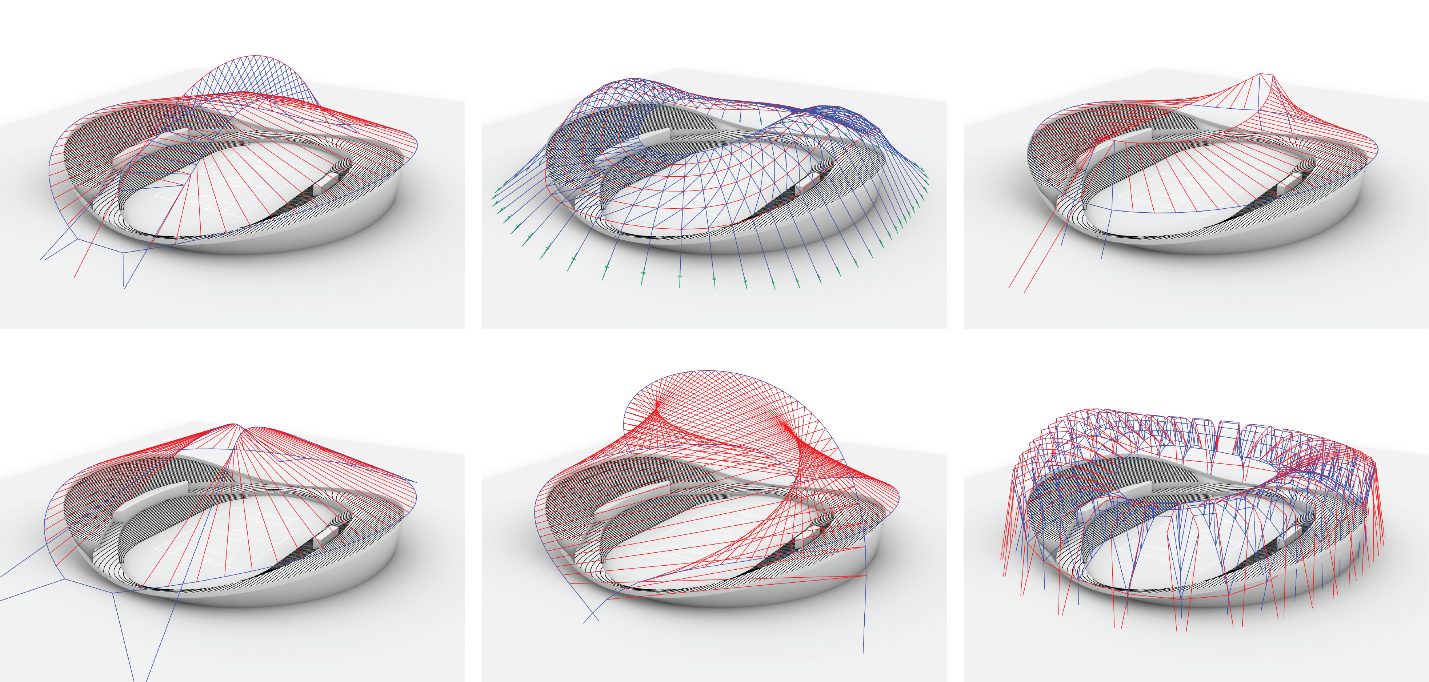 |
|||||
Pre-Conference WorkshopsTwo workshops will be organized before the conference, on Saturday 5 and Sunday 6, in parallel, at the conference venue the Crowne Plaza Hotel. The schedule will be available soon. The workshops can be attended separately from the conference. Should you interested in participating in one of the workshops please register by September 27 at the very latest.
Elastic gridshells with K2Engineering The workshop will focus in the design and analysis of cable restrained elastic gridshells using Kangaroo2 and K2Engineering. The workshop will introduce a theoretical framework of bending-active gridshells , and several strategies to design and simulate them, including physical models, form-finding, loading and verifications. The goal is to generate a complete workflow to optimize gridshells by cable-restraining or corrugations using Harmonics plugin and evolutionary solvers (i.e. Biomorpher). The workshop will cover several construction strategies and emphasize in the feasibility, proposing an adaptable cylindrical chebyshev net. Finally the gridshell will be built with 14mm GFRP rods and will be used to calibrate and validate the simulation.
Recommended prerequisites: Familiarity with Rhino, Grasshopper and Kangaroo2
Computational structural design using graphic statics The aim of this workshop is to introduce the students to the fascinating world of computational equilibrium design using graphic statics. The workshop consists of three main parts. In the first part, the basic concepts of graphic statics and equilibrium modelling will be explained. In the second part, the computational framework COMPAS will be introduced with the aim of creating an operational bridge between graphic statics, equilibrium modeling and the digital environment. In the third part, the Combinatorial Equilibrium Modelling (CEM) will be used as a package of COMPAS to demonstrate the potential of designing simultaneously with form and forces. A small case study will be used for this exploration. More details about the three different parts can be found below. Part 1 - Basics of Equilibrium Modelling using Graphic Statics (ca. 2 hours) In this part, the fundamental concepts of graphic statics and equilibrium modelling will be introduced. Graphic statics is a set of geometric constructions that relate the form of a structure in static equilibrium with the forces acting on it. It is based on two reciprocal diagrams: a form diagram that represents the geometry of the structure together with its external forces; a force diagram that embeds a synthetic vector representation of the forces applied to each node of the structure. First applied as a mean to analyze 2D structures, structural designers soon recognized it as a unique method for finding new structural forms. Recent research has been developed towards the extension of graphic statics to the third dimension. Thanks to the lower bound theorem of the theory of plasticity, graphic statics can be used as an operative tool for equilibrium modelling. Part 2 - Introduction to COMPAS (ca. 6 hours) COMPAS is an open source framework for computational research and collaboration in architecture, engineering, fabrication and construction. During this part of the workshop we will address the following topics:
Part 3 - Combinatorial Equilibrium Modelling (ca. 4 hours) The aim of this part is to introduce the participants to a design method for the generation of equilibrated structures in three-dimensions using graphic statics and the Combinatorial Equilibrium Modelling (CEM). CEM is an innovative approach to structural design in which, contrary to other equilibrium-based form finding approaches, the equilibrium condition is inherent to the model and does not require any numerical simulation to be computed. CEM is grounded on vector-based 3D graphic statics and graph theory and allows the designers to take full advantage of the relationship between topology, form and structural behavior during the early stages of the design process. To make this approach operative, an interactive, computer-aided design tool has been integrated within the COMPAS framework. The tool enables the designers to work in real-time and in an intuitive way to generate non-conventional 3D spatial networks in equilibrium (form diagram) for any designer-specified connectivity, any combination of compression and tension forces (topological diagram) and any set of force magnitudes (force diagram). Info about the tutors:
Tom Van Mele
Pierluigi D’Acunto
Patrick Ole Ohlbrock Pictures 
Generated equilibrium states for the design of a stadium roof |
|||||
| Nº VISITS 1463384 |
|
International Centre for Numerical Methods in Engineering Barcelona, Spain Telf. + 34 - 93 405 46 96 - Fax. + 34 - 93 205 83 47 membranes@cimne.upc.edu Copyright © 2018 CIMNE, All Rights Reserved. |